I am a member of the Dutch association of Vinologists (Verenigde Vinologen Nederland) and after the great wine trips with the association to Piemonte, Lombardia, and Australia, I have now organized a trip to Campania in Italy as a member of the travel committee of the VVN, with Fred Nijhuis as our guide.
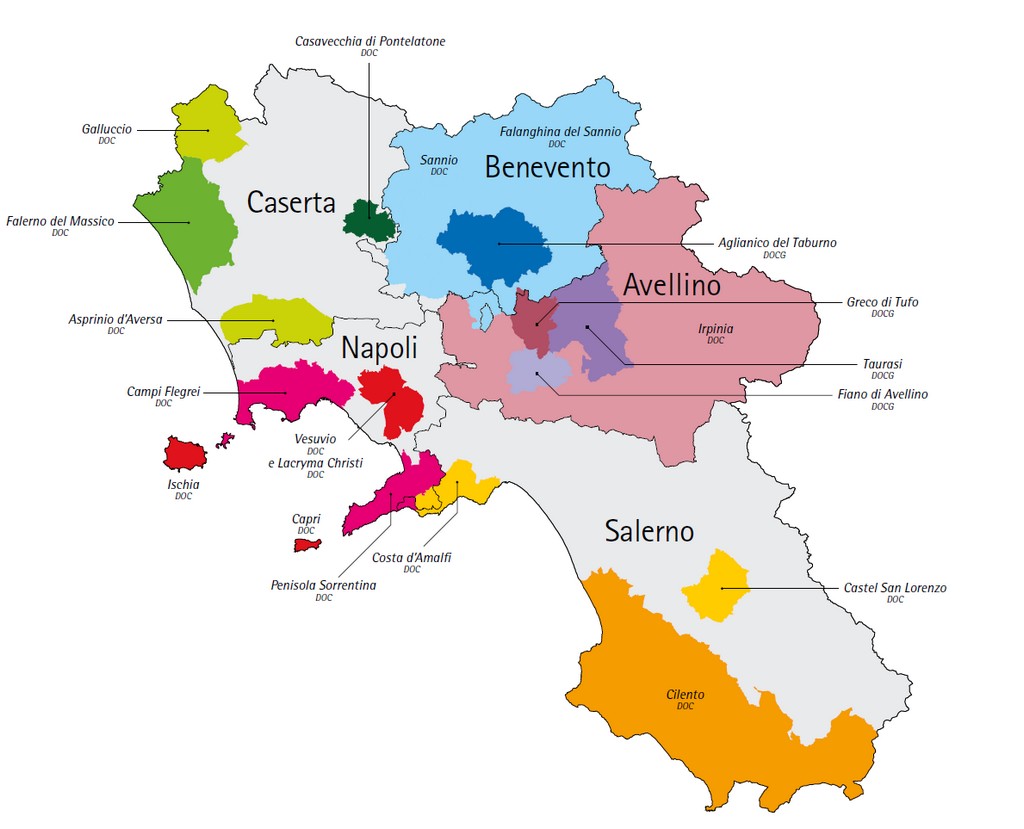
Campania is a region in the South of Italy, with Naples as its capital. Campania has:
- 4 DOCGs: Taurasi, Greco di Tufo, Fiano di Avellino, Aglianico del Taburno;
- 15 DOCs: Ischia, Capri, Vesuvio, Cilento, Falerno del Massico, Castel San Lorenzo, Aversa, Penisola Sorrentina, Campi Flegrei, Costa d’Amalfi, Galluccio, Sannio, Irpinia, Casavecchia di Pontelatone, Falanghina del Sannio;
- 10 IGTs: Colli di Salerno, Dugenta, Epomeo, Paestum, Pompeiano, Roccamonfina, Beneventano, Terre del Volturno, Campania, Catalanesca del Monte Somma.
During this trip we will visit all of the DOCGs and a large portion of the DOCs and IGTs. Our tour was supposed to start with a visit to Villa Matilde and the Vitica consortium of wines from the province of Caserta, but because our plane had a very long delay of more than 3 hours, we unfortunately had to cancel that part of our tour.
Hostaria Manfredi, Atripalda

This is why this account of our tour starts with an improvised dinner at Hosteria Manfredi in our hotel in Atripaldi, rather than telling you about Villa Matilde and the wines of the Caserta province. I messaged with the hotel manager to arrange this dinner while we were waiting for our flight to leave on the tarmac at Schiphol Airport in Amsterdam. You can’t just show up unannounced for dinner with a group of 15.

Of course there had to be wine. We chose wines from producers that we were not going to visit on the tour. These are the wines we enjoyed:
- Caggiano Campania Falanghina IGT 2022: nicely fruity
- Caggiano Béchar Fiano di Avellino DOCG 2022
- Caggiano Devon Greco di Tufo DOCG 2023: well structured
- Benito Ferrara Vigna Cicogna Greco di Tufo DOCG: highly aromatic
- Sertura Irpinia Rosata DOC (Aglianico): full-bodied rosé that was a good pairing for the pasta with zucchini pesto
- Caggiano Vigna Macchia Dei Goti Taurasi DOCG 2019: nice fruit and tannins, and a good pairing for the beef tagliata
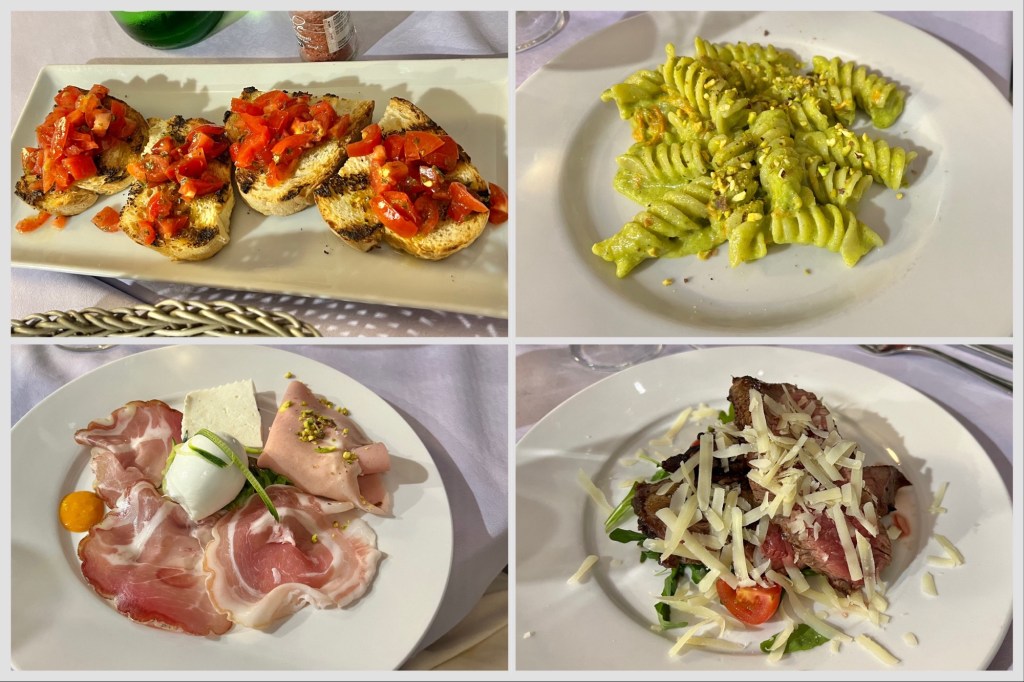
As antipasti we had various salumi and cheeses, mortadella with ricotta and pistachios, and tomato bruschetta. The primo was fusilloni pasta with a zucchini pesto and zucchini flowers, sprinkled with chopped pistachios. The secondo was beef tagliata with rucola, cherry tomatoes, and grana cheese.
Consorzio Sannio
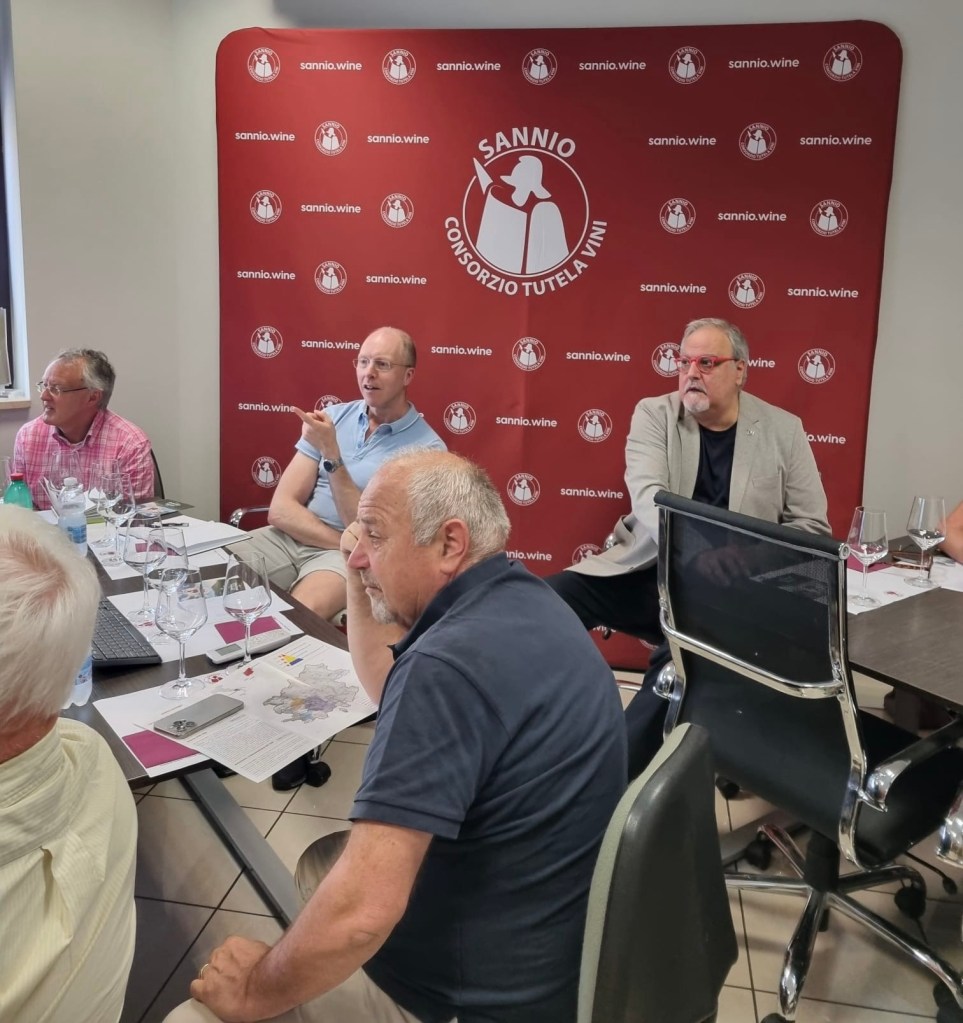
The whole province of Benevento is also the wine region Sannio. We were received by Nicola Matarazzo, director of the Sannio Consorzio Tutela Vini. As Mr Matarazzo presented in Italian, I translated everything into Dutch for the group.
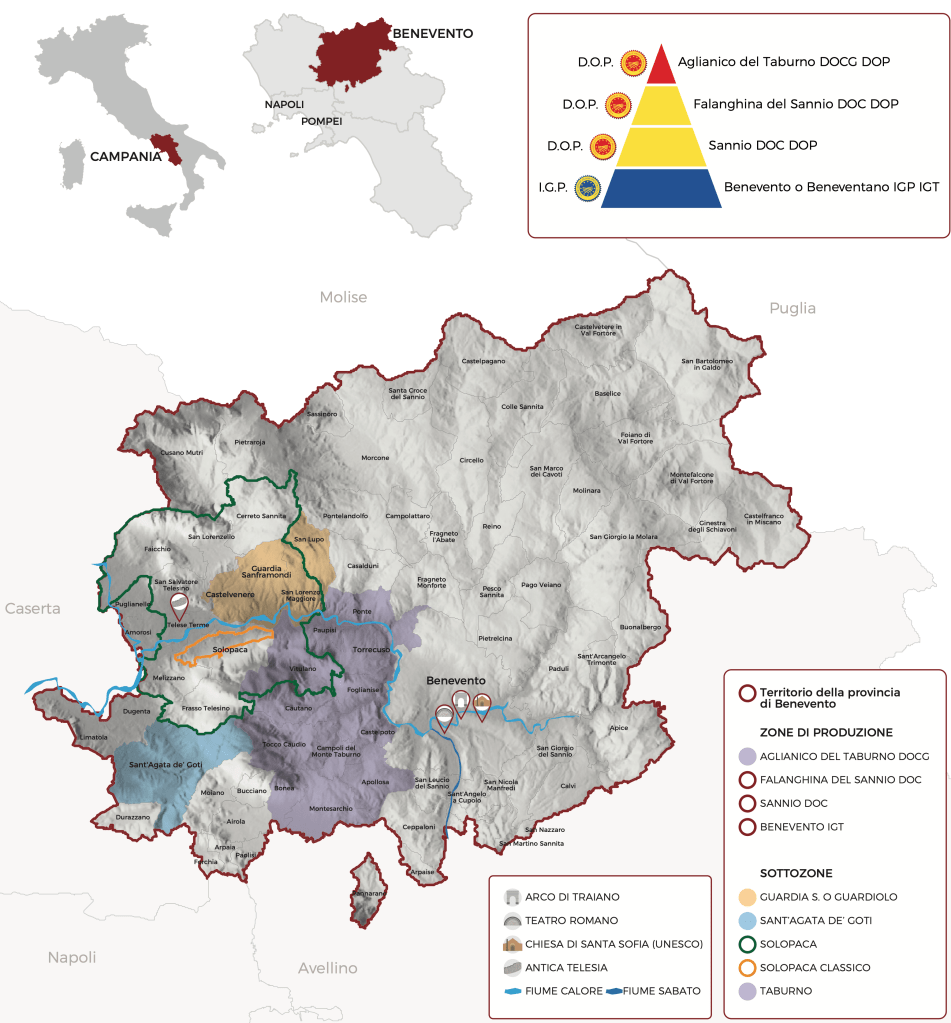
Wines with the denomination Falanghina del Sannio DOC, Sannio DOC, or Benevento IGT can be produced anywhere in the province. Aglianico del Taburno can only be produced in a specific zone. Sannio DOC has some subzones like Sant’Agata dei Goti, which is mentioned on the label if a wine is produced in such a subzone. There are 10,000 hectares (25,000 acres) of vineyards in Sannio, and 100 wineries. The province of Benevento produces half of all the wine of Campania. The main grape varieties of Sannio are Falanghina for white and Aglianico for red, but there are also other grape varieties like Sommarello, Piedirosso, Sciascinoso, Agostinella, Cerreto, Coda di Volpe, Greco, Malvasia, Fiano, Passolara di San Bartolomeo, Olivella, Carminiello, Palombina, and Moscato di Baselice. The terroir is created by mountains to the south and to the north that cause a certain flow of air, hills and slopes, large temperature differences, and many different soil types. The vineyards are around 400 meters above sea level.

95% of all Falanghina produced in Italy, is produced in Campania, and 80% of that in Benevento. There are actually two grape varieties that are genetically different, but both called Falanghina: Benevento and Flegrea. In Sannio it is mostly the Benevento. In their youth the wines have aromas of banana, apple, lemon blossoms, and eucalyptus. Falanghina can age very well and will develop notes of clove, pineapple, pine needles, and saltiness. The first bottle of varietal Falanghina was sold in 1979 by Mustilli, a winery that we visited later on the same day. Now 6 million bottles of Falanghina del Sannio are sold annually.
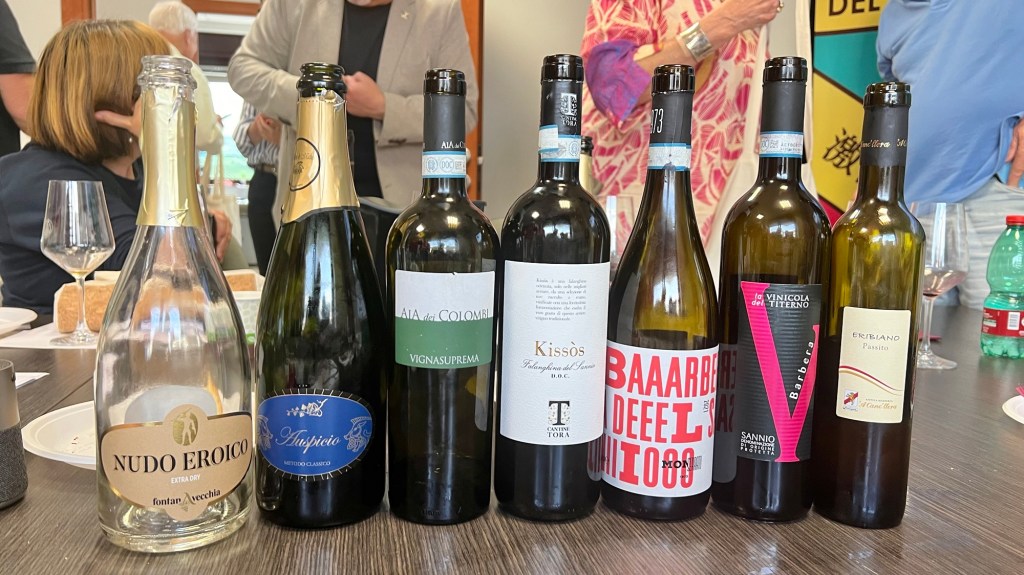
After the presentation we tasted a selection of wines from Sannio:
- Fontanavecchia, Nudo Eroico (sparkling Falanghina made with the Charmet method, extra dry): mineral notes and grapefruit
- Vigne di Malies, Auspicio Falanghina Metodo Classico Brut Nature (aged 36 months on the lees): toasted almonds, pineapple, fresh, full body, fine mousse
- Aia dei Colombi Falanghina del Sannio DOC 2022 (aged sur lie with battonage): creamy and complex
- Cantine Tora, Kissòs Falanghina del Sannio DOC 2017 (slow cold fermentation and aged sur lie): golden color, aroma of pine needles, full bodied and creamy, complex and balanced, long finish.
- Barbera del Sannio DOC 2021 (100% Camaiola): very fruity, high acidity (from the hills at 300-500 meters above sea level)
- La Vinicola del Titerno Barbera del Sannio 2020 (100% Camaiola): more tannic, some herbaceous notes (from the valley, alluvial soil)
- Antica Masseria ‘A canc’llera, Eribiano Agostinella Passito 2019 (ripens in August, is then left on the vines to dry out until the harvest in October, and then dried in a shed for a further 6 weeks): fresh, not very sweet, balanced, complex
There were two grape varieties that I had not tasted before: Camaiola and Agostinella. What is known as Barbera in Sannio is not actually Barbera as we know it from Piemonte, but a completely different grape variety called Camaiola. This has only been discovered recently. The bureaucratic process has been started to officially change the name, so it can be put on the label as Camaiola instead of Barbera.
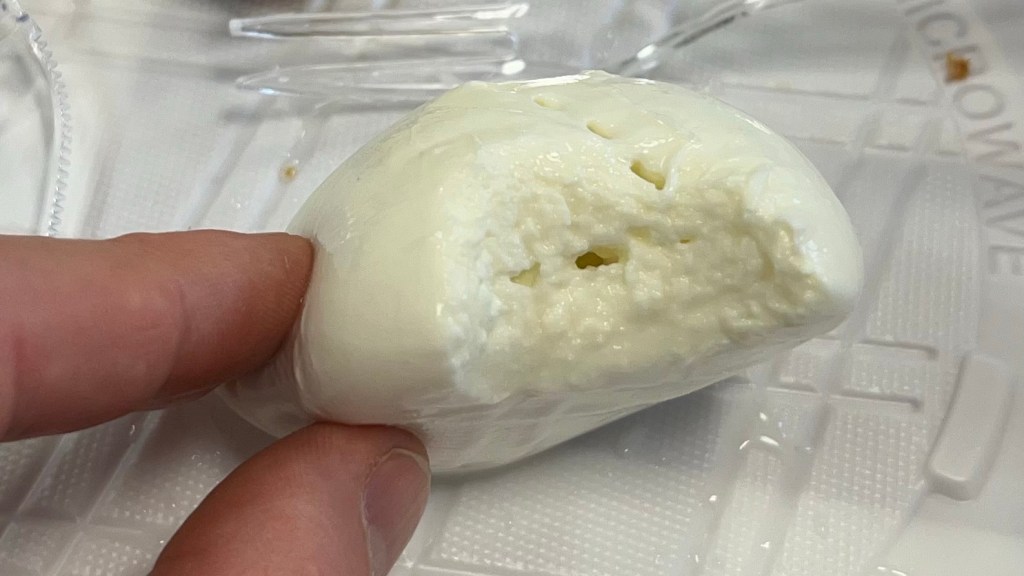
We also enjoyed some fresh buffalo mozzarella from Campania (Mozzarella di Bufala Campana DOP). Mr Matarazzo explained that you can recognize fresh buffalo mozzarella by the texture, which should not be grainy and have some irregularities as you can see in the photo, and should be elastic. Also, the skin on the outside should not come off easily. Buffalo mozzarella should NOT be stored in the refrigerator, and it is ideal to consume it 8 hours after it has been produced (not sooner, not later). The aromas are of butter and milk. It pairs well with Falanghina.
Fontanavecchia

Fontanavecchia is a family-owned winery in the Sannio area. There are currently three generations of the Rillo family working at the winery. Libero is the head of the winery and also president of the consorzio. His father Orazio is still the cellar master. They produce about 200,000 bottles per year.
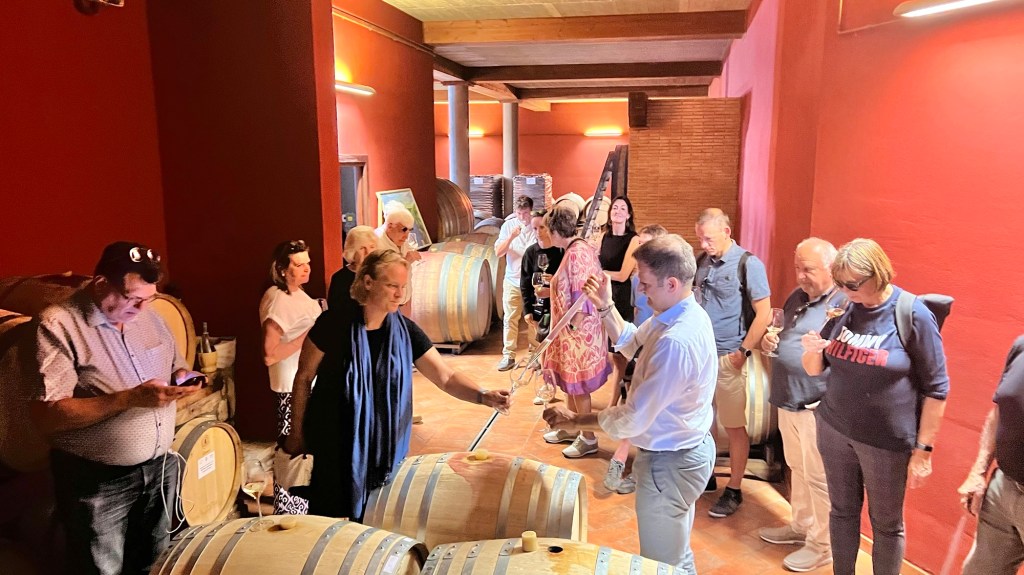
Libero gave us a tour of the winery, with me translating from Italian into Dutch again. We tasted the oak-aged Falanghina and Aglianico del Taburno directly from the barrel.
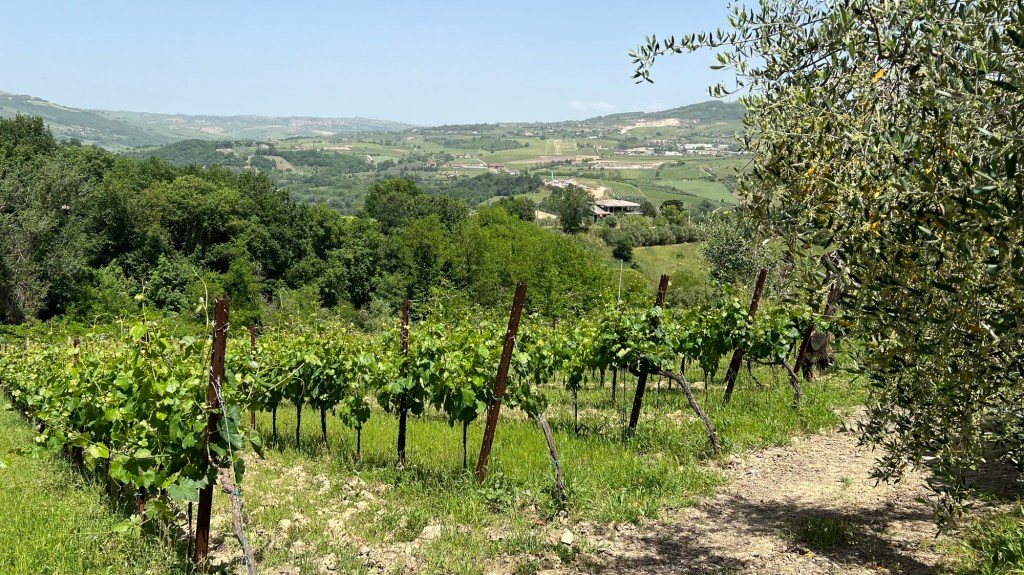
Fontanavecchia is located near the village of Torrecuso and was established in the 19th century. But the Rillo family has been making wine here for over 600 years.
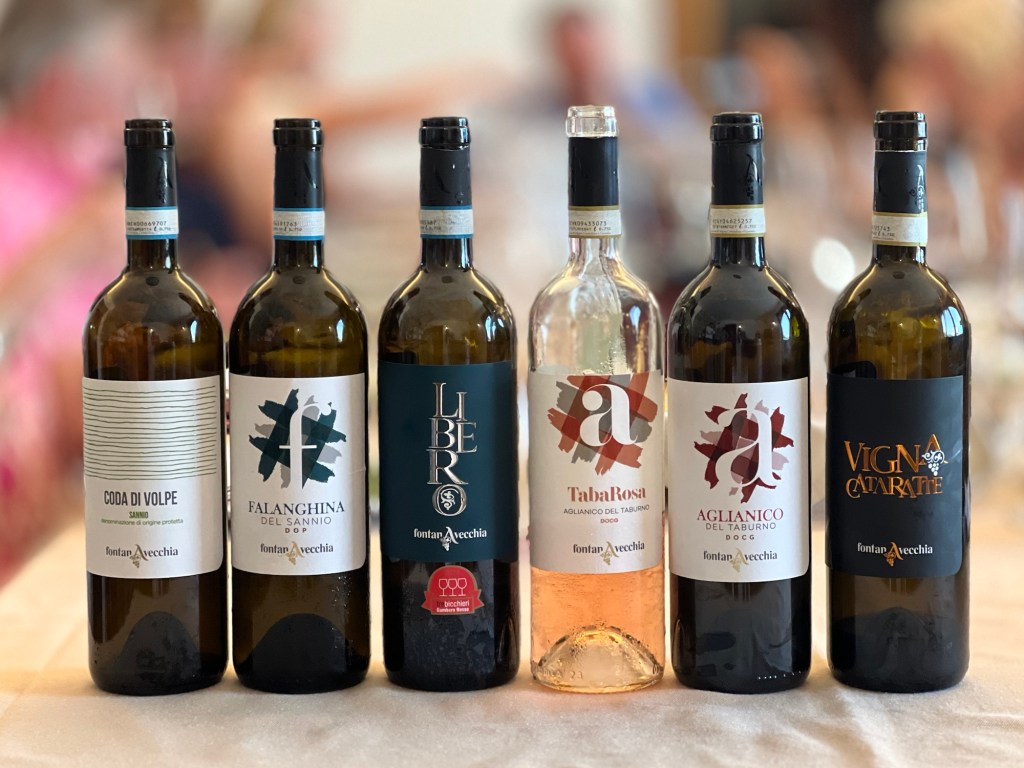
These are the wines we tasted:
- Falanghina del Sannio DOC 2023 (40% of the production of the winery, made in stainless steel): fruity and fresh but with structure and body
- Libero Falanghina del Sannio Vendemmia Tardiva DOC 2019 (late harvest, 20% 9 months of French oak on the lees with stirring, 80% in stainless steel, can age for 20 years): creamy, complex, balanced, aromatic, nice oak, but still a bit present (needs more time in the bottle)
- Coda di Volpe 2023 (made in stainless steel): salty, gentle acidity
- TabaRosa 2023 Aglianico del Taburno DOCG Rosé: fresh, balanced, in the style of Provence
- Aglianico del Taburno DOCG 2019: present acidity, full bodied, soft tannins
- Vigna Cataratta Aglianico del Taburno Riserva DOCG 2018 (single vineyard, 14 months French oak, 3 years bottle): soft but present tannins, some minty aromas

We tasted the wines over a very nice lunch, prepared by Rillo’s mother. It included various antipasti including Parmigiano di Melanzane, a vegetable frittata, and ciambotta, which in this case was a mash of beans with green leavy vegetables. This was followed by a primo of pasta e fagioli, pasta with beans in vegetable broth. The primo paired very nicely with the rosé.
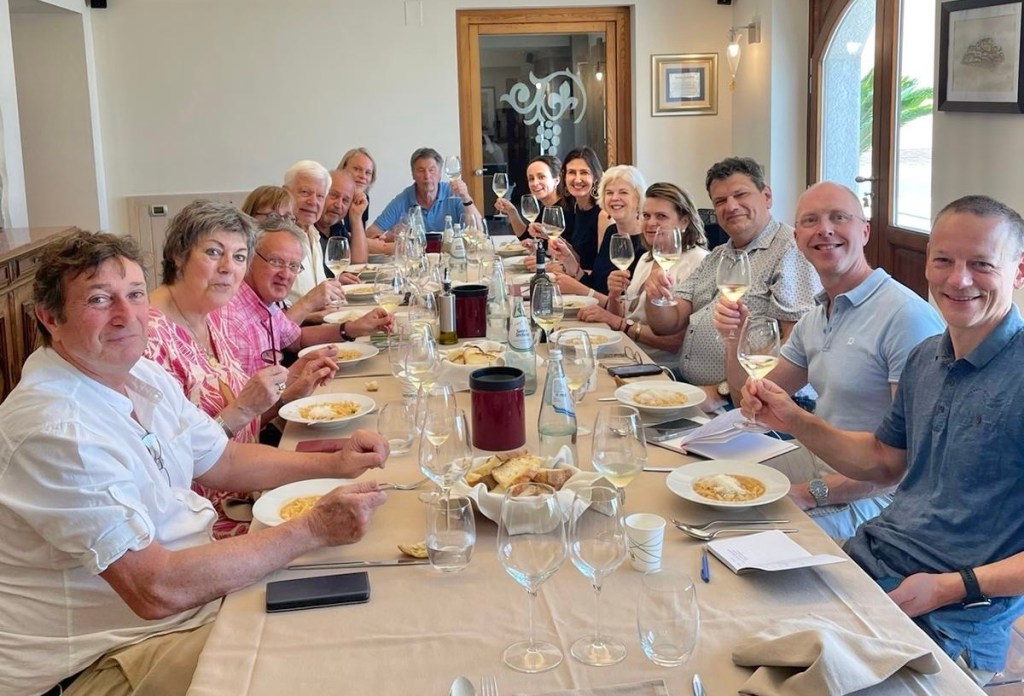
Terre Stregate
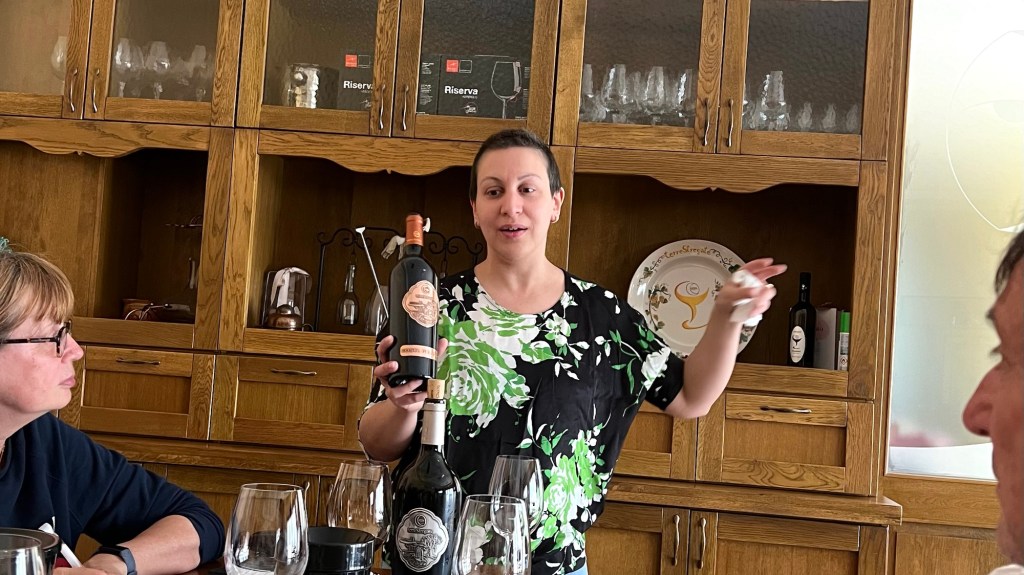
Our next visit in Sannio was to Terre Stregate. Also a family business, started in 1898 by Filippo Iacobucci. Filomena, the daughter of current 5th generation owner Carlo, gave us a passionate presentation of the wines. The name of the winery means “bewitched lands”, and refers to local legends about witches. They have 25 hectares (60 acres) of vineyards, with mostly Falanghina and Aglianico. The Falanghina is produced in 4 versions: still, sparkling, late harvest, and passito. They also produce olive oil.
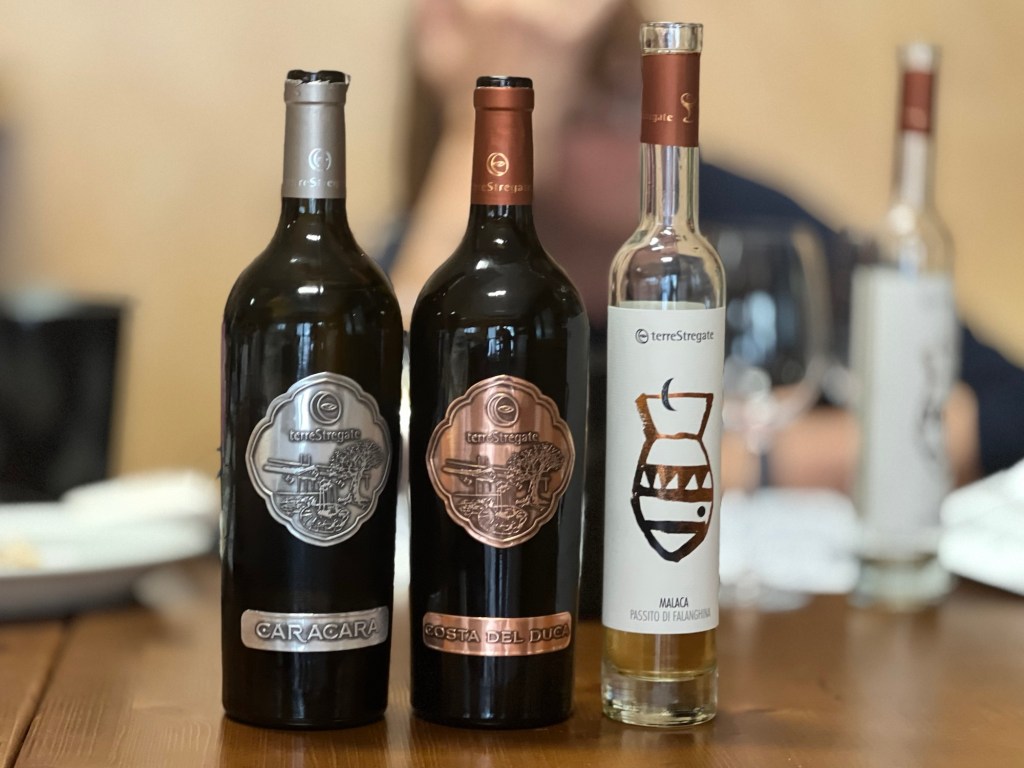
The wines we tasted here were:
- Caracara 2019, Falanghina IGP Beneventano (single vineyard with vines of 30+ years old, not declared as Falanghina del Sannio DOC because they are not sure about the percentage of Falanghina in the vineyard, late harvest at the end of October, low yield, aged for 3 to 4 months in used barriques, only 2000 bottles produced): aromatic, elegant, creamy, mineral, beautiful fruit, fresh for its age.
- Costa del Duca 2016, Aglianico IGP Beneventano (again not as the DOC because there is also some Sciacinoso in the vineyard, 6 months in used oak and cherry barriques, not produced every vintage, only 1800 bottles produced): dark cherries, soft tannins.
- Malaca 2019 Passito del Falanghina (60% weight loss from drying the grapes, very slow fermentation because of the high sugar content of the most): soft and not too sweet, some eucalyptus aromas.
Mustilli
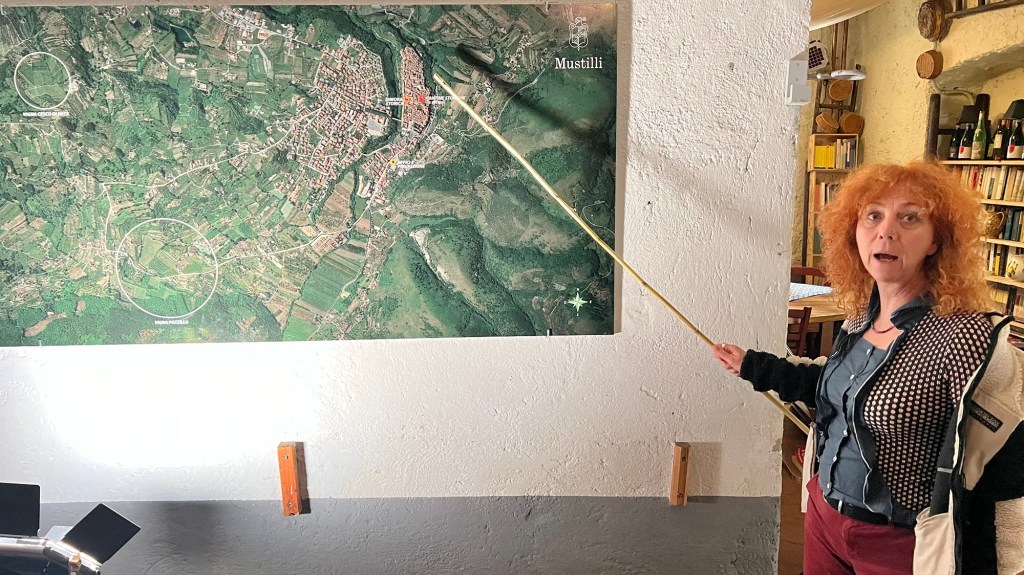
We ended our tour of Sannio with Mustilli in the subzone Sant’Agata dei Goti. We were received in the historic cellar (constructed in the 15th century) of the winery by current owner Paola Mustilli. Mustilli is a small winery that produces only 80,000 bottles per year of Falanghina and Greco (white), Piedirosso and Aglianico (red).

Her father identified 18 different autochtonous varieties in the 1960s. He used them to make wines in a tiny production and tasted them. He decided to plant Falanghina and sold the first bottle in 1979. Now millions of bottles of Falanghina del Sannio are sold annually (of which only a very small percentage by Mustilli).
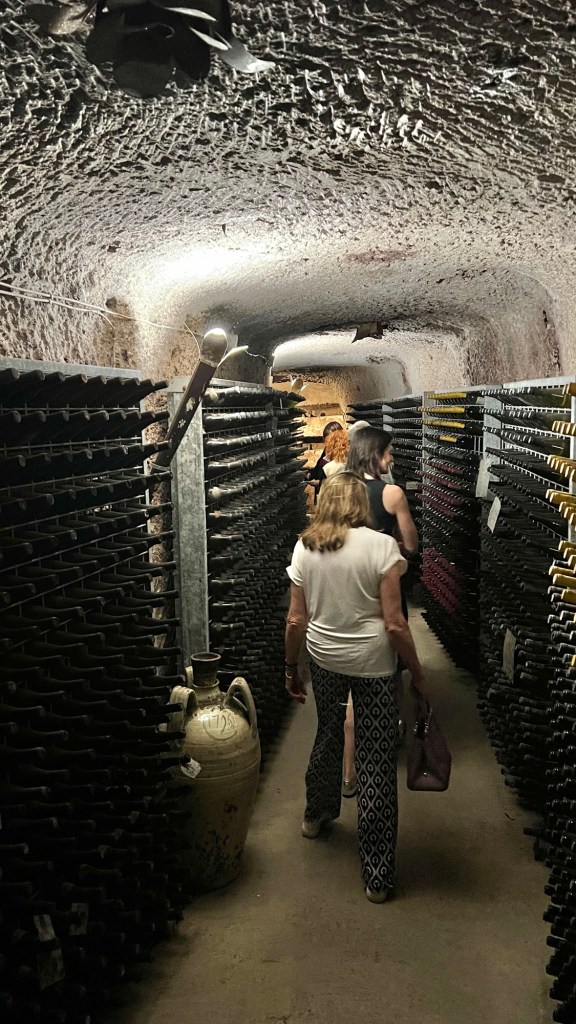
In 2002 Mustilli moved the production from the historic cellar to a modern winery. They kept the historic cellar as a kind of museum, which we visited.
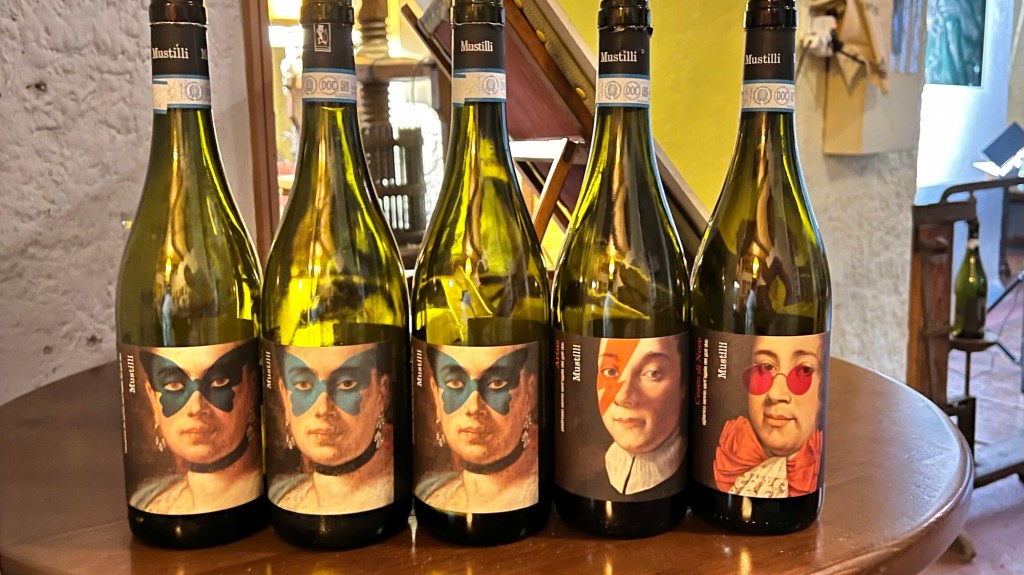
We tasted the following wines:
- Vigna Segreta Falanghina del Sannio Sant’Agata dei Goti DOC (Falanghina Beneventano on clay and limestone soil, mass selection, made in stainless steel and aged for 9 months on the lees with stirring):
- 2022: fresh and crispy
- 2019: creamy, beautiful aroma, my favorite
- 2017: crispy and balanced
- Artus Piedirosso del Sannio Sant’Agata dei Goti DOC 2019 (10 months in amphora, only 12% alcohol): coffee, tannins, fresh
- Cesco di Nece Aglianico del Sannio Sant’Agata dei Goti DOC 2017 (single vineyard, 12 months in French oak): structured, fresh, medium bodied.
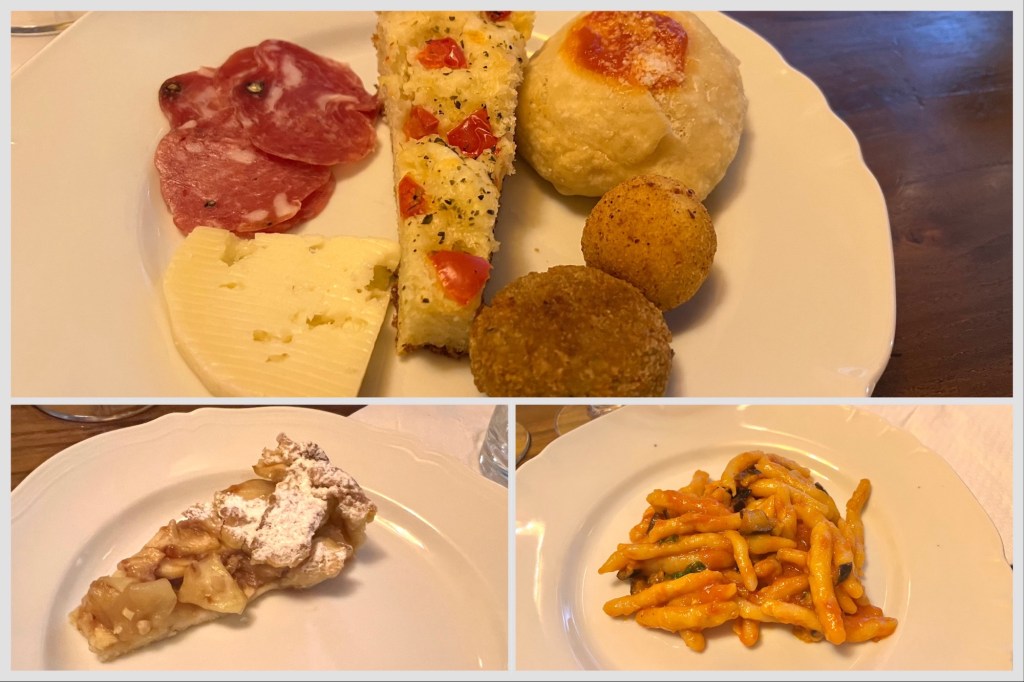
We tasted the wines over dinner, which consisted of various antipasti (soppressata, pecorino, focaccia, rice and lemon zest croquette, eggplant croquette), handmade pasta with fresh tomato sauce and eggplant, and apple tart.
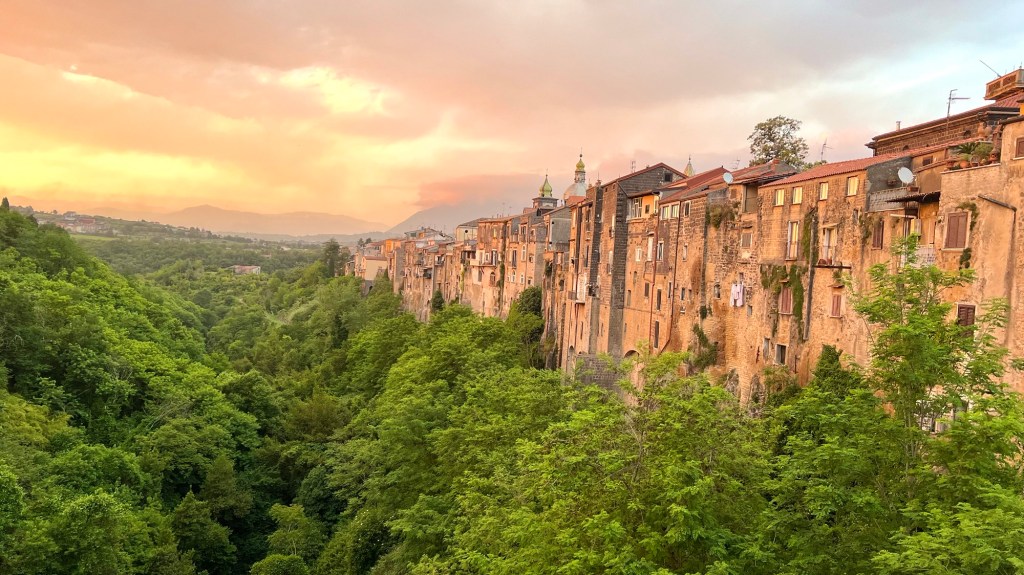
On the short walk back from the winery to the bus, we had a wonderful view of the historic town of Sant’Agata dei Goti to end our visit to Sannio.


The last photo is beautiful! What a lovely trip. Your language skills are so impressive!
LikeLiked by 1 person
This looks like a wonderful trip. I wonder if you ever have run into Yuri Buono, a member of the “slow food” movement in Italy and proprietor of the former Vincanto in Pompeii. Among other things here is my blog post about Vincanto from 2018 https://todaysworry.blog/2018/03/13/the-joys-of-a-lard-sandwich-3-12-18/
LikeLiked by 1 person
Have read your post, but had not heard of Yuri Bruno before.
LikeLike
welcome back to Italy
LikeLiked by 1 person